Clothes elevator: Difference between revisions
play with image layout |
m Adamw moved page Draft:Clothes elevator to Clothes elevator: good enough to be safe |
||
(No difference)
| |||
Revision as of 21:40, 10 February 2024

I was surprised to find that Berlin working-class life doesn't typically include luxuries such as an electric clothes dryer, as fundamental to US citizenship as pre-sliced cheese or cable TV. What one does instead is to take up half a room with a tin pot drying rack, which folds down only to leap up again and mock me as I unfurl it later the same day.
I live with four people of varied ages and our laundry is a legitimate mini-job for tax purposes.
Winter makes this whole deal all the more challenging since cold plus damp equals mildew; heating a room is expensive; the windows are drafty... and waah did I mention that winter is long cold and dark, best endured from behind a protective shield of fidgety little indoor projects.
Pulleys: how does that work?
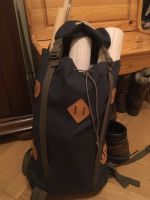
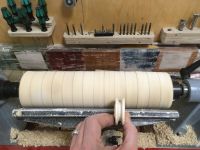

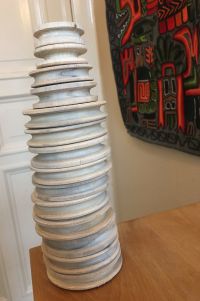
Like any hobbyist, I started with the funnest part: pulleys. Window shopping told me the pulleys would add up to at least a hundred bucks so I decided to buy a wood lathe for 200 bucks, get creative about "renting" storage space under a table in a basement, and learn how to turn my own pulleys.[1] First world problems, you could say. But after some learning, my pulleys came out alright!
Mechanical engineering is not my thing, which is unfortunate because I enjoy making stuff that is used and should not fall apart. In my wake lie garden tools that bend, shelves that fall out of the wall, and bicycle trailers that tip their load on a rainy night. I once tried to find an evening continuing ed. class on the subject. To my surprise this isn't how it works—nobody wants their city's bridge designed by a punter who picked it up from odd nights out and a couple of video explainers. But still, I blame elitism.
For this reason and other factors, it's taken me a few years of building up courage to try a clothes elevator. The problem seemed harder than it is, at first: unattainably mathy with so many different angles and lengths to consider... the idea stagnated and each time I sketched it came out obviously wrong and incomplete. The turning point was to learn that pulleys simply change the direction of force, and this direction can be constrained or constant.
In other words, the rope's travel is equal but opposite as seen from either side of a pulley. If the pulleys stay put it gets even simpler, and all that's happening in my case is that downwards pulling force on a rope is rotated by 90° at the ceiling, and then another 90° so that it's acting upwards on the load. This is just the fancy equivalent of a 180° turn over a single pulley [img].
A second-best bed
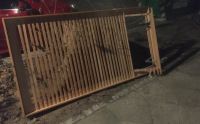

A year or two passes. But one crappy afternoon I stumbled across a huge oak bed on the street. Having spent my youth observing city trash floes, I recognized this for the incredibly attractive nuisance it is and I rushed home to get the tools to dismantle it. Indeed, by the time I returned, scavengers or vandals had chewed or stomped a dozen of the sticks out and... I'm curious what the stumps could even be used for: firewood, a small dishtowel rack, jagged ski poles for a baby? It's cold and dark out and I'm doing something ambiguous in public, it's not my place to ask these questions. I unscrewed what remained, tossed the sticks into an innocuous getaway stroller and walked back home hunched over my prize.
The slats are perfect: hardwood at roughly 2.5cm x 1cm x 1.0m. Beveling the business edges and sanding to 180 grit or so leaves the wood smooth enough for cloth to slide over but rough enough not slip. I forgot to sand the sticks before assembly, it gets unwieldy.
Tie it together
Aluminum angle serve admirably for the runners, and aluminum[2] pop rivets holding slats to the runners keep the overall weight down.[weigh it]
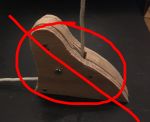
Mounting the pulleys however had me at a loss for bad ideas. Here's one example, a monstrosity of scrap plywood. It's cute that the pulley is invisible, but there's nothing else good happening here.
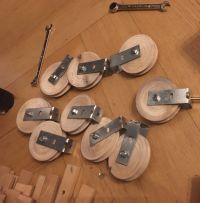

Bending whatever metal strapping around the pulleys is fine and leaves me free to use any type of bolt appropriate for the mysterious ceiling. The axle should have been simple, let's not discuss how overcomplicated I made this, out of a disproportionate urge to use up old junk. Just... if you too choose to hang anything unusual above your head, please lock all threads one way or another.
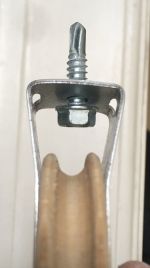
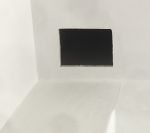

By a stroke of luck, I found that the bathroom ceiling included a few metal studs, which I trust to give hints before catastrophic failure, unlike the ancient concrete and plaster powder everywhere else in the apartment. And even luckier, a strange little access door provides a clutch of extra metal to anchor to, all in the spot directly above a door jamb where I planned to anchor to anyway. If you don't have a little door like this, it will provide insight, it's low risk—and you might lure a family of Borrowers.
Sombras, nada mas

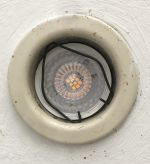
The ceiling lights were distracting: our old halogen spotlights immediately burn out and don't illuminate much to begin with. I jammed some LED flood bulbs in the housing, and used telegraph wire to make clips that hold these in place. The flood bulb angle also helps reflect light off of the walls to get around the humungous new obstruction.
Results

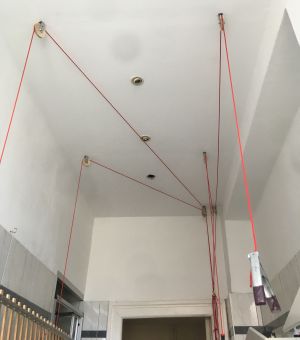
This rack turns out to fit three or so loads of laundry, which adds up to more weight than is comfortable to lift. A 5-to-1 block and tackle system was straightforward to make from two pairs of double pulleys, which I boringly purchased at the big box like it is the Industrial Age. This part should run smoothly and be less likely to explode, so no regrets.
Finally, the reward is that local children will enthusiastically run the winches while singing "Scrub, Scrub".
Notes
- ↑ I enjoyed Frank Pain's book "Practical Woodturner", and the genre encourages great videos.
- ↑ Weird side note: different types of metal touching one another do a molecular-electrical Galvanic corrosion thing over time.
